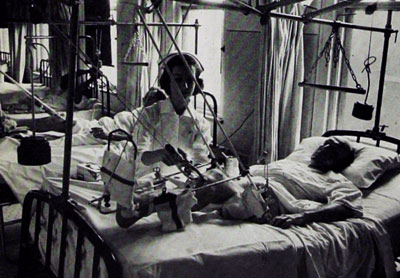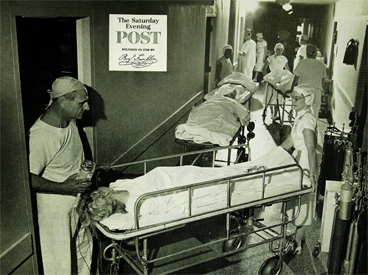Today we are still arguing over who’s responsible for the high cost of healthcare. Get the facts on health insurance in this investigative three-part series from 1958.
[See also: “Fixing Our Healthcare System” from our Sep/Oct 2012 issue.]
Is This the Pattern of the Future?
Part I: The History of Health Insurance in the United States
Part II: The High Cost of Chiseling
June 21, 1958—Here’s how employees of one company prepay all their family medical bills via a comprehensive group plan. For them, sickness can never mean financial ruin.

For many years, a number of General Electric engineers and executives had been members of a private association called the Elfun Society. At their meetings in Schenectady, New York, and other cities, they talked about community service projects, company improvements and how to invest their savings in stocks and bonds. Also, since many of the members were young men with growing families, they talked informally about school setups, Parent-Teacher Associations, household budgets, and medical bills.
“It’s those medical bills that really scare the daylights out of me,” an engineer said, one evening back in 1946. “We’re on such a tight budget at our house that any serious illness could wreck us.”
“Why don’t you get some health insurance?” a friend asked.
“You mean the kind that’ll pay a couple of hundred bucks if you get sick? That wouldn’t help. A couple of hundred—I could pay that without too much trouble. But what do I do if I get hit with a bill for a thousand dollars? Or two thousand? Even on my salary, that’d be a catastrophe!”
“So get some insurance that just pays the big bills.”
“I tried,” said the engineer. “There isn’t any such thing.”
At the time, the G.E. men discovered, no insurance company was prepared to provide protection against the costs of medical catastrophes. They went to friends in the insurance industry and urged them to try such policies, but they were repeatedly turned down.
“There’s no need for it,” a New York insurance executive said.
“It would be certain to fail,” said a Connecticut expert.
“Maybe it might work,” admitted the representative of a New Jersey company, “but the industry won’t be ready to try it for at least 10 years.”
Finally, the Liberty Mutual Insurance Company, of Boston, agreed to an experiment. Working with a committee of the Elfun Society, it prepared an experimental policy patterned somewhat after automobile collision insurance. There was a so-called deductible, obliging the policyholder to pay the first $300 of the bills for any illness. There was also a co-insurance feature, requiring him to pay 25 percent of the rest of the bill. The ceiling for any one illness was set at $1,500. Introduced early in 1949, this was apparently the first catastrophic or major medical health-insurance policy ever sold.
The experiment succeeded beyond the wildest expectations. The new idea spread from the Elfun Society into General Electric and then into other industries. Other insurance companies adopted the idea, setting the deductible portion anywhere from $100 to $500, and raising the ceiling for anyone illness to $5,000, $7,500, and even $15,000. By 1952, approximately 700,000 people were covered; 2 million by 1954; 9 million by 1956; and 13 million by the end of 1957.
Most of the major-medical policies paid in the form of cash, rather than services, allowed free choice of doctor and hospital, and involved no fee schedule to control the doctor’s charge. At the outset, these provisions won an enthusiastic reception, especially from medical groups. Dr. David Allman, president of the American Medical Association, said last year, “No physician can consider this type of insurance a threat to medical practice.”
Organized labor was not so optimistic. “Major medical,” warned one union leader, “can merely mean more money in circulation to pay higher doctor bills, with the patient no better off.”
Regardless of this and similar objections, the creation of major medical, or catastrophic, health insurance was widely and highly admired, and insurance companies won considerable praise for their enterprise. To insurance executives such a warm reaction was exhilarating and also somewhat unusual. Until recently, health insurance companies were widely depicted as remote, cold-hearted corporations interested in collecting premiums, adamantly refusing to pay justifiable claims, and seeking to amass great profits for their stockholders.
Actually, few major insurance companies are set up as profit-making concerns. Most are nonprofit or mutual corporations; if they make any money, these funds are returned each year to their policyholders in the form of cash, reduced premiums or paid-up insurance.
On the other hand, as some insurance men themselves admit, there have been grounds for hard feelings. In the past, companies have put out individual policies which they could cancel at will if their experience proved unfavorable—a maneuver which one expert describes as “perhaps good economics, but remarkably poor public relations.” More recently, some companies or their more zealous agents have indulged in outright misrepresentation as to what their policies did and did not cover. Last year, the Better Business Bureau of Boston, felt obliged to warn customers that “there is no magic which can furnish broad insurance coverage and sweeping protection at unbelievable bargain rates … one can’t buy steak for the price of turnips.”
Many conservative insurance leaders still view with dismay the efforts to sell health insurance—especially the more expensive individual policies—on an emotionally supercharged level. Some salesmen admittedly utilize such high-pressure tactics. In one how-to-do-it article published last year in the insurance magazine, Accident and Sickness Review, a Chicago agent warned his fellow salesmen against the prospect who “desires to study the plans we have offered and perhaps wants to look into other plans.” Encountering such a client, he said, the salesman should counterattack with approaches like these: “Do you know the exact provisions of your auto insurance or, for that matter, any of your insurance policies? … Would you drive your car without insurance? Does your body or your income deserve less? … You trusted someone to insure your car, life, and so on. If you don’t have coverage, it’s better to have some protection than none.”
In contrast, Joseph F. Follmann, Jr., of the Health Insurance Association of America, has suggested, “In the long run, we believe the interests of the prospect—and thus of the company—will be served best by a chance to size up all proposed plans, carefully and unemotionally, and to select the program which most closely fits his needs and his pocketbook.”
To meet such requirements, insurance companies—along with Blue Cross and Blue Shield—have experimented with such ideas as noncancelable or guaranteed renewable policies, policies which provide at least some coverage for mental disease, Paid-Up-At-65 policies, economical group coverage for farmers, and the new nationwide Medicare health insurance program for military dependents. Among these new experimental ideas was catastrophic, or major medical, coverage, which was greeted upon its introduction with considerable enthusiasm.
Within a very few years, it became apparent that major-medical insurance was by no means foolproof. The deductible and co-insurance features made it difficult for patients to abuse their policies, but not impossible. Even in the absence of fee schedules, and with ceilings as high as $10,000 or more for a single illness, the vast majority of doctors exercised restraint and discretion, but some did not. Unfortunately, an increasing number of physicians in some areas began to render extraordinarily high bills for their services. Only a few months ago, one company in California regretfully announced that it was forced to go back to the restrictive fee-schedule system to keep doctors’ bills in line.
Furthermore, there were growing signs of collusion between physician and patient. In such a conspiracy, investigators discovered, the procedure was usually something like this: Joe Doakes, with a stone in his kidney and a touch of larceny in his heart, would find that a kidney operation—including charges for the surgeon, the hospital, nurses, and miscellaneous items—would cost him $800. Under the terms of his policy, he would have to put out in cash the deductible amount of $200, and then 20 percent of the remaining $600, or $120.
Become a Saturday Evening Post member and enjoy unlimited access. Subscribe now



